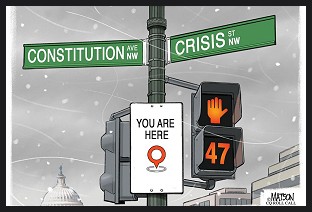 As we near the one year mark since some 18,000 votes inexplicably disappeared in Sarasota County, Florida, on the Direct Recording Electronic (DRE) touch-screen voting machines used in the U.S. House Election for the state's 13th Congressional District, more study is still needed to determine whether or not the voting machines were at fault, according to the report released today by the Government Accountability Office (GAO).
As we near the one year mark since some 18,000 votes inexplicably disappeared in Sarasota County, Florida, on the Direct Recording Electronic (DRE) touch-screen voting machines used in the U.S. House Election for the state's 13th Congressional District, more study is still needed to determine whether or not the voting machines were at fault, according to the report released today by the Government Accountability Office (GAO).
Even with the additional testing, the GAO admits, it will be impossible to determine for certain whether the touch-screen machines caused the extraordinarily high undervote race in the election.
The GAO's report [PDF] was presented to a Congressional task force investigating the challenge brought by Democratic candidate Christine Jennings, under the Federal Contested Elections Act, after the certified tally between her and her Republican opponent, Vern Buchanan, was reported by the state to be a slim 369 vote margin.
No reasonable explanation for the massive undervote --- found only in that particular contest, only in the Sarasota portion of the race, and only on the touch-screen ballots there (as opposed to the paper-based absentee ballots) --- has yet been proven by anyone.
 The GAO has asked the task force to allow them to conduct further testing of the ES&S iVotronic touch-screen machines, in three specific areas, though they admit while "the proposed tests could help provide increased assurance, they would not provide absolute assurance that the iVotronic DREs did not cause the large undervote in Sarasota County."
The GAO has asked the task force to allow them to conduct further testing of the ES&S iVotronic touch-screen machines, in three specific areas, though they admit while "the proposed tests could help provide increased assurance, they would not provide absolute assurance that the iVotronic DREs did not cause the large undervote in Sarasota County."
Determining for certain whether the machines caused the problem would be "impossible," according to the GAO analysis, because they are "unable to recreate the conditions of the election in which the undervote occurred." Ah, the trouble with touch-screens.
As well, the report determined that "some of the prior tests and reviews conducted by the State of Florida and Sarasota County provide assurance that certain components of the voting systems in Sarasota County functioned correctly, but they are not enough to provide reasonable assurance that the iVotronic DREs did not contribute to the undervote."
While the Congressional task force has given permission for the GAO to proceed with their additional testing of the DREs, Jennings has already announced her intentions to run again in 2008 and Buchanan has voted for almost a full year with the Republican House caucus. And Democrats in the House prepare to vote on legislation which would allow the same faulty technology to be used in further elections.
QUESTIONS ABOUT ES&S CONTINUE
Among the unanswered questions in any of the FL-13 reports so far, is whether or not the source code reviewed in previous studies was the same as the code actually in use in the machines on Election Day. Recent news out of California demonstrates that ES&S has a prior history of playing fast and loose with different versions of hardware and software used on their machines in elections.
As well, reading past the summary section of the GAO report reveals another troubling disclosure by the nation's largest voting machine vendor...
During the course of California Sec. of State Debra Bowen's landmark independent "Top-to-Bottom Review" of certified voting systems in California, ES&S had refused to supply source code for the company's InkaVote system used in Los Angeles to her University of California testers. Only a threat to take the source code out of state escrow forced the company to turn over the code, along with a demand that Bowen's computer scientists not work from the escrowed version.
As The BRAD BLOG first reported last July, Bowen's team subsequently found that the version of the source code supplied by ES&S was different from the one used for certification and as stored in escrow by state law.
Further, in August, Bowen then announced that she had discovered ES&S had deployed a different version of the AutoMARK voting system from the one which had been certified for use in the state of California on 1000 different machines. In 2004 a similar use of uncertified touch-screen systems by Diebold, Inc., had led to the decertification of its systems in the state. A hearing is pending this month to determine what the penalties will be for ES&S.
One of the three additional tests the GAO plans to conduct in their investigation of ES&S's FL-13 machines is to try and determine whether or not the machines and source code used in prior testing match the firmware used in the voting machines in Sarasota County, Florida, on election day.
A "key shortcoming" of both their own study and the prior study commissioned and run by the state of Florida "was the lack of assurance whether the source code reviewed...if compiled, would correspond to the iVotronic firmware that was used in Sarasota County for the 2006 election."
The GAO found that "prior testing and activities do not provide reasonable assurance that all iVotronic DREs used in Sarasota County on election day were using the hardware and firmware certified for use by the Florida Division of Elections."
Another troubling note was revealed deeper inside the GAO's study. They report that ES&S officials, who, along with the state of Florida and Sarasota County, were allowed to review the study before its release today, admitted they were unable to provide the results of earlier tests they claimed were performed on the machines. The results of tests performed on Sarasota's iVotronics back in 2001 and 2002 were unavailable "because the documentation had not been retained," according to the company.
A recent investigative report by Dan Rather Reports revealed that little testing was performed by the company during those years when their systems were manufactured, secretly, in a sweatshop factory in The Philippines. The sum total of the testing at the factory, according to employees interviewed in Rather's report, was a "shake test" in which the machines were shaken after they were built, in order to determine if they contained any loose pieces. (The video and transcript from Rather's extraordinary report is available here.)
ES&S SEES NO PROBLEMS, THE GAO DISAGREES
As well, ES&S told the GAO that they felt "the collective results of prior testing have demonstrated that the voting systems worked properly in Florida’s 13th Congressional District race."
The GAO did not concur with ES&S' assessment. "We disagree that the prior test results adequately demonstrate that the voting systems could not have contributed to the undervote," they wrote in reply.
The scope of the GAO's report was to determine whether or not the ES&S iVotronic systems used on Election Day in November 2006 contributed to the extraordinarily high undervote rate. So far, they say, they have been unable to reach "reasonable assurance" that machine malfunction or tampering played a roll.
While they admit it will be impossible to determine one way or another, they hope the additional testing will provide such a "reasonable assurance."
ONE YEAR ON
In the meantime, during the same election last November, citizens in Sarasota voted to move to an election system which included a "paper trail" record of their votes. The FL-13 debacle, however, led Florida's new Republican Governor, Charlie Christ, to move the state's Republican legislature to ban DRE voting machines entirely.
And yet, even with all of that, Congressional Democrats in the U.S. House prepare to vote --- as early as next week, if Majority Leader Steny Hoyer has his way --- on Rush Holt's (D-NJ) Election Reform bill (HR 811).
Despite multiple warnings from computer scientists and security experts, as well as many election integrity advocates, Holt's bill would nonetheless allow for the continued use of the same type of DRE voting technology which, even a year later, one scientific study after another has failed to show as accurately having reflected the intent of Sarasota's voters.
###
A few other notable details from the GAO report on Florida's 13th Congressional District Election follow below...
...
Our proposed tests could help reduce the possibility that the undervote was caused by the iVotronic DREs. However, even after completing the tests, we would not have absolute assurance that the iVotronic DREs did not play any role in the large undervote. Absolute assurance is impossible to achieve because we are unable to recreate the conditions of the election in which the undervote occurred.
...
We concluded that the results from the testing of 10 machines cannot be applied to all 1,499 iVotronic DREs used during the 2006 general election because the sample was not random and the sample size was too small.
...
Out of 112 different ways to select a candidate in the congressional race, Florida certification tests and the Sarasota County logic and accuracy tests verified 3 ways to select a candidate; and the Florida parallel tests verified 10 ways to select a candidate—meaning that of the 112 ways, 13 have been tested. By not verifying these different ways to select a candidate, we do not have reasonable assurance that the system will properly handle expected forms of voter behavior.
...
Our proposed tests involving the firmware comparison, ballot testing, and calibration testing could help reduce the possibility that the undervote was caused by the iVotronic DREs. However, even after completing the tests, we would not have absolute assurance that the iVotronic DREs did not play any role in the large undervote. Absolute assurance is impossible to achieve because we are unable to recreate the conditions of the election in which the undervote occurred.


 Campaign to 'Impeach Trump Again' Gains Fresh Momentum: 'BradCast' 4/29/25
Campaign to 'Impeach Trump Again' Gains Fresh Momentum: 'BradCast' 4/29/25 'Green News Report' 4/29/25
'Green News Report' 4/29/25
 And Then They Came for the Judges...: 'BradCast' 4/28/25
And Then They Came for the Judges...: 'BradCast' 4/28/25 Sunday 'Desperation' Toons
Sunday 'Desperation' Toons Trump EPA Guts Enviro Justice Office: 'BradCast' 4/24/25
Trump EPA Guts Enviro Justice Office: 'BradCast' 4/24/25 'Green News Report' 4/24/25
'Green News Report' 4/24/25 Nation's Largest Broadcaster Hoaxes Viewers to Help Gut FCC Rules: 'BradCast' 4/23/25
Nation's Largest Broadcaster Hoaxes Viewers to Help Gut FCC Rules: 'BradCast' 4/23/25 Trump's FCC on Precipice of Ending All Limits on Corporate Control of Local TV Stations
Trump's FCC on Precipice of Ending All Limits on Corporate Control of Local TV Stations GOP Earth Day 2025 Hypocrisies and Dilemmas: 'BradCast' 4/22/25
GOP Earth Day 2025 Hypocrisies and Dilemmas: 'BradCast' 4/22/25 'Green News Report' 4/22/25
'Green News Report' 4/22/25 Pope Francis Dies, Trump Still Alive and Criming: 'BradCast' 4/21/25
Pope Francis Dies, Trump Still Alive and Criming: 'BradCast' 4/21/25 Sunday
Sunday  Sunday 'Zero Day' Toons
Sunday 'Zero Day' Toons 'Green News Report' 4/10/25
'Green News Report' 4/10/25 Soc. Sec. Expert Warns DOGE of Collapse, Privatization: 'BradCast' 4/10/2025
Soc. Sec. Expert Warns DOGE of Collapse, Privatization: 'BradCast' 4/10/2025 Trump Blinks, Chaos Reigns, Markets Spike Amid Tariff 'Pause': 'BradCast' 4/9/25
Trump Blinks, Chaos Reigns, Markets Spike Amid Tariff 'Pause': 'BradCast' 4/9/25 SCOTUS Deportation Ruling Grimmer Than First Appears: 'BradCast' 4/8/25
SCOTUS Deportation Ruling Grimmer Than First Appears: 'BradCast' 4/8/25 Cliff Diving with Donald: 'BradCast' 4/7/25
Cliff Diving with Donald: 'BradCast' 4/7/25 'Mob Boss' Trump's Trade Sanctions Tank U.S., World Markets: 'BradCast' 4/3/25
'Mob Boss' Trump's Trade Sanctions Tank U.S., World Markets: 'BradCast' 4/3/25 Crawford Landslide in WI; Booker Makes History in U.S. Senate: 'BradCast' 4/2/25
Crawford Landslide in WI; Booker Makes History in U.S. Senate: 'BradCast' 4/2/25 Judge Ends Challenge to GA's Unverifiable, Insecure Vote System: 'BradCast' 4/1/25
Judge Ends Challenge to GA's Unverifiable, Insecure Vote System: 'BradCast' 4/1/25 Bad Court, Election News for Trump is Good News for U.S.: 'BradCast' 3/31
Bad Court, Election News for Trump is Good News for U.S.: 'BradCast' 3/31
 VA GOP VOTER REG FRAUDSTER OFF HOOK
VA GOP VOTER REG FRAUDSTER OFF HOOK Criminal GOP Voter Registration Fraud Probe Expanding in VA
Criminal GOP Voter Registration Fraud Probe Expanding in VA DOJ PROBE SOUGHT AFTER VA ARREST
DOJ PROBE SOUGHT AFTER VA ARREST Arrest in VA: GOP Voter Reg Scandal Widens
Arrest in VA: GOP Voter Reg Scandal Widens ALL TOGETHER: ROVE, SPROUL, KOCHS, RNC
ALL TOGETHER: ROVE, SPROUL, KOCHS, RNC LATimes: RNC's 'Fired' Sproul Working for Repubs in 'as Many as 30 States'
LATimes: RNC's 'Fired' Sproul Working for Repubs in 'as Many as 30 States' 'Fired' Sproul Group 'Cloned', Still Working for Republicans in At Least 10 States
'Fired' Sproul Group 'Cloned', Still Working for Republicans in At Least 10 States FINALLY: FOX ON GOP REG FRAUD SCANDAL
FINALLY: FOX ON GOP REG FRAUD SCANDAL COLORADO FOLLOWS FLORIDA WITH GOP CRIMINAL INVESTIGATION
COLORADO FOLLOWS FLORIDA WITH GOP CRIMINAL INVESTIGATION CRIMINAL PROBE LAUNCHED INTO GOP VOTER REGISTRATION FRAUD SCANDAL IN FL
CRIMINAL PROBE LAUNCHED INTO GOP VOTER REGISTRATION FRAUD SCANDAL IN FL Brad Breaks PA Photo ID & GOP Registration Fraud Scandal News on Hartmann TV
Brad Breaks PA Photo ID & GOP Registration Fraud Scandal News on Hartmann TV  CAUGHT ON TAPE: COORDINATED NATIONWIDE GOP VOTER REG SCAM
CAUGHT ON TAPE: COORDINATED NATIONWIDE GOP VOTER REG SCAM CRIMINAL ELECTION FRAUD COMPLAINT FILED AGAINST GOP 'FRAUD' FIRM
CRIMINAL ELECTION FRAUD COMPLAINT FILED AGAINST GOP 'FRAUD' FIRM RICK SCOTT GETS ROLLED IN GOP REGISTRATION FRAUD SCANDAL
RICK SCOTT GETS ROLLED IN GOP REGISTRATION FRAUD SCANDAL VIDEO: Brad Breaks GOP Reg Fraud Scandal on Hartmann TV
VIDEO: Brad Breaks GOP Reg Fraud Scandal on Hartmann TV RNC FIRES NATIONAL VOTER REGISTRATION FIRM FOR FRAUD
RNC FIRES NATIONAL VOTER REGISTRATION FIRM FOR FRAUD EXCLUSIVE: Intvw w/ FL Official Who First Discovered GOP Reg Fraud
EXCLUSIVE: Intvw w/ FL Official Who First Discovered GOP Reg Fraud GOP REGISTRATION FRAUD FOUND IN FL
GOP REGISTRATION FRAUD FOUND IN FL


































